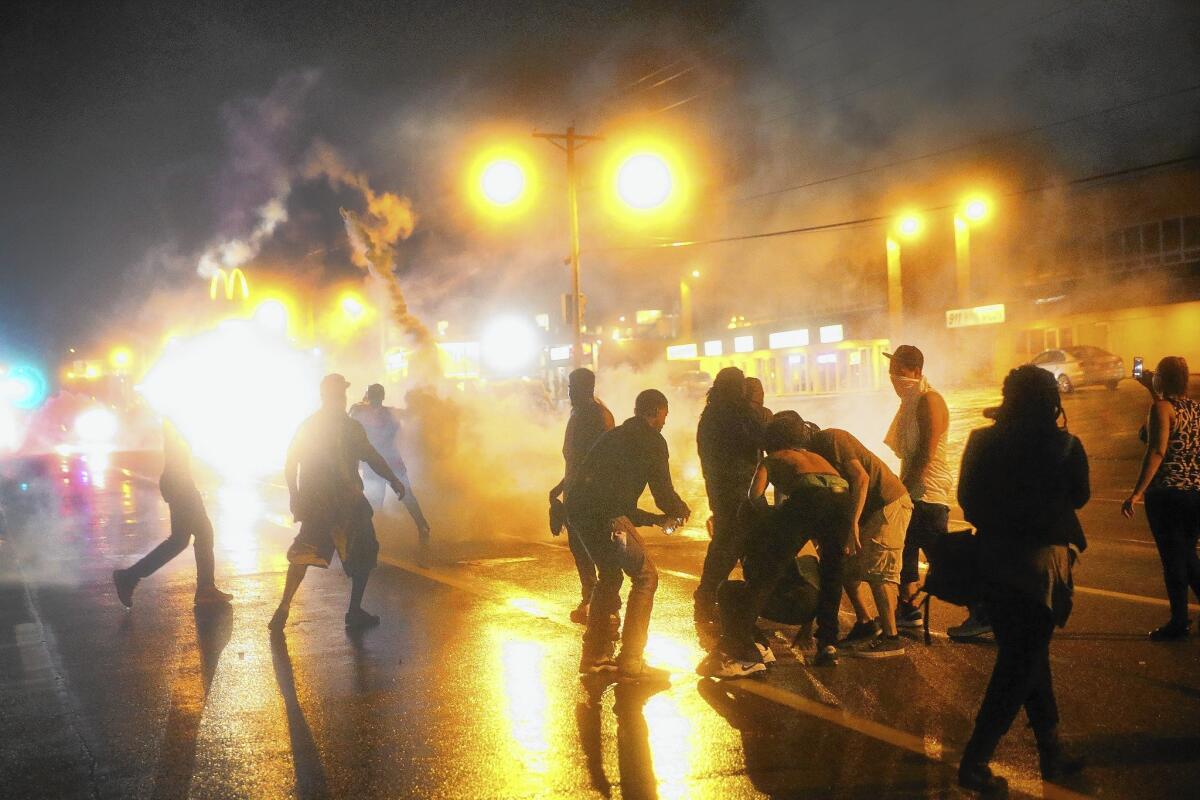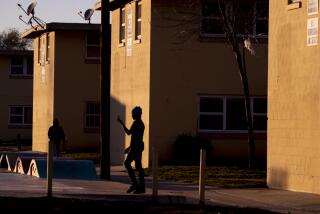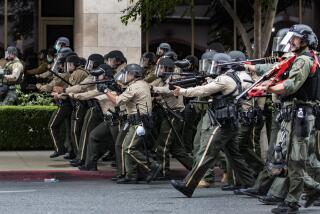No answers yet on how to end the turmoil in Ferguson

Reporting from FERGUSON, Mo. — Bottles had been lobbed by the angry crowd, but it was still about an hour before protesters would begin lighting blazes and firing guns at police officers. Tear gas had yet to waft down the streets, but a weary Capt. Ron Johnson was losing patience.
“What’s on my mind is, this has to stop, it has to stop,” Johnson told television interviewers early Tuesday. “People in the streets are saying it’s got to stop. [But] the people who are bent on this aren’t going to stop. … If we all go away, they are going to be in this mall.”
Eleven days into protests spurred by the shooting death of Michael Brown — an unarmed black 18-year-old killed by a white police officer — law enforcement officials and community leaders here still have not figured out how to bring an end to the turmoil in this racially polarized St. Louis suburb.
A curfew failed to calm the protesters. So did the curfew’s end. An early show of police force only inflamed the riots, and recent low-key National Guard mobilization hasn’t worked either. Johnson’s arrival helped for about a day, but the Missouri State Highway Patrol member — a black man who calls the Ferguson area home and was put in charge of law enforcement here after Brown’s death — could only do so much.
Brown’s parents said Tuesday that the way to quell the demonstrations that have put this small city on edge would be to arrest Darren Wilson, the police officer who shot their son.
“Justice will bring peace,” Brown’s mother, Lesley McSpadden, told the “Today” show’s Matt Lauer.
History, however, does not necessarily bear that view out.
Consider the case of Oscar Grant, a young black man who was shot to death by a white transit officer in Oakland in 2009. After BART Officer Johannes Mehserle was sentenced to two years in jail in Grant’s death, violent protests broke out in Oakland. Hundreds marched. Windows were smashed. Police in riot gear responded.
“The police have missed their chance to be peacemakers in this,” said Robert McCrie, a professor of security management at John Jay College of Criminal Justice. “Possibly the presence of African American leadership, like the presence of the attorney general, will help. A walk through the street by President Obama would be an exciting moment of leadership. But I don’t know whether something like that would occur.”
Obama has yet to visit Ferguson, but U.S. Atty. Gen. Eric H. Holder Jr. arrived here Wednesday for closed-door sessions with Missouri Gov. Jay Nixon, community leaders, FBI investigators and federal prosecutors, plus a community meeting at the Florissant Valley campus of St. Louis Community College. Before being briefed by the FBI Wednesday, Holder said that he hoped his visit “will have a calming influence on area.”
Law enforcement experts consider open-ended protests such as the one in Ferguson — like those after Grant’s death and the Los Angeles riots of 1992 — to be the most difficult type of civil unrest for authorities to manage.
In contrast, the riots that occurred during the World Trade Organization meetings in Seattle in 1999 had a natural end point: the last day of the conference. Although the weeklong incident became synonymous with heavy-handed policing, it did not drag on indefinitely.
Still, former Seattle Police Chief Norm Stamper, who calls the WTO riots “the biggest mistake in my 34 years of law enforcement,” said that “everything we know about the history of these kinds of conflicts is they will eventually come to an end.... [But] you can’t expect them to stop suddenly.”
The best short-term solution for Ferguson’s woes, Stamper said, would be for someone in authority — the mayor, the police chief, the governor, Johnson — to assemble a “wide circle of critics, supporters, community activists, civic leaders, a politician or two, police officers from the various ranks, put them in a room and have a conversation.”
They need to take stock, Stamper said, and have a “reasonable” ground rule or two, including an agreement that they will not resolve the issue of the shooting itself. The Police Department must demilitarize immediately, he added, and the investigation into Brown’s death must be thorough and the process transparent. Law enforcement officers must communicate with residents every step of the way.
“Policing is the public’s business,” he said, “and the public has a right to know.”
This city of 21,000 is largely black, and the police force and power structure are overwhelmingly white. There is little trust in the community and no reservoir of goodwill — crucial components that help cities weather difficult circumstances, like the Aug. 11 Los Angeles shooting of Ezell Ford. A black 25-year-old with a history of mental illness, Ford was shot to death by two members of the Los Angeles Police Department’s gang task force.
As in the case of Brown, there are conflicting accounts of what happened on West 65th Street. And on Sunday hundreds took to the streets in protest. But the similarities end there.
“Why wasn’t that march violent?” asked retired Los Angeles Deputy Police Chief Stephen Downing. “Before the crisis even happened, there was a reservoir of goodwill built up in the last years, starting with [former Chief William J.] Bratton and continuing through with [current Chief] Charlie Beck.
“Also, their SWAT team stays in the barn until there’s a specific reason that justifies use of their training and their equipment,” Downing said. “They roll when there is an active shooter or a barricaded suspect, and the chain of command decides.”
As the Ferguson protests continue with no end in sight, at least one city is trying to prepare itself should a similar situation arise there. In Nashville on Thursday, police, religious leaders, politicians and citizens plan to meet to try to figure out how the city would respond in case of such a disturbance.
The depth of the problem in Ferguson is not lost on Nixon, the Missouri governor. In a message delivered Tuesday evening, he acknowledged the rift.
“Once we have achieved peace in Ferguson and justice for the family of Michael Brown,” Nixon said, “we must remain committed to rebuilding the trust that has been lost, mending what has been broken, and healing the wounds we have endured.”
That charge is imperative, he said, but it will be neither simple nor quick.
Because people like Carl Dix will need to be persuaded. The New Yorker was arrested in Ferguson and charged with failure to disperse. After being released from jail Tuesday, he vowed that the protests would go on.
“We ain’t stopping,” Dix said, “and neither are the people of Ferguson.”
Twitter: @marialaganga
Twitter @tinasusman
La Ganga reported from Seattle and Susman from Ferguson. Times staff writers Richard A. Serrano in Washington and Cathleen Decker in Los Angeles contributed to this report.
More to Read
Sign up for Essential California
The most important California stories and recommendations in your inbox every morning.
You may occasionally receive promotional content from the Los Angeles Times.












